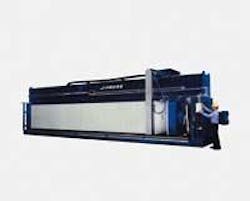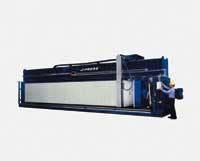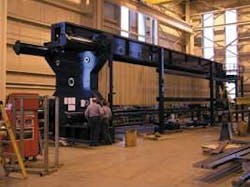Membrane filter presses gain popularity in Asia
By David Shaw and Bob Hamm
Dewatering alum residuals is a worldwide challenge as growing populations and expanding industries call for the construction of more water treatment plants.
In Asia, many countries have taken a proactive stand on dewatering alum sludge due to overburdened drying beds and increased public scrutiny. Prior to setting the final design and equipment specifications, water companies frequently visit existing installations to review operational and maintenance data and to check the viability of installing a similar system in their plants. Where applicable, on-site pilot testing is also widely used to set meaningful process and equipment guarantees.
Several mechanical dewatering methods are available. The mixed-pack membrane filter press dewaters alum sludge to the highest cake dry solids, uses fewer chemicals for sludge coagulation and produces the best quality filtrate in a cost-effective, efficient and environmentally friendly manner.
Coagulation is the most frequently used and accepted treatment technology of drinking water sources. Aluminium sulphate (also called "alum") or a similar metal salt is used as a primary coagulant for removing turbidity, colour, bacteria, algae and other organic compounds from surface or groundwater.
Alum residuals, which are sedimentation basin (or clarifier) sludge and filter backwash wastes from the coagulation process, accumulate in the water, forming larger particles. A sludge thickener is used to increase the solids content of the combined wastes. The thickened solids are then settled or filtered out before they are pumped to the dewatering equipment.
Polymer or another solids-producing chemical, such as powdered activated carbon, clay, lime or activated silica, is used to condition the sludge and improve its dewaterability. The sludge is then dewatered in filter presses equipped with membrane squeeze plates. These presses achieve higher dry solids concentrations in the dewatered filter cake than do other types of dewatering equipment.
Comprising approximately 70% of the sludge produced by water treatment plants, sedimentation sludge and filter backwash wastes are some of the most difficult solids to treat.
The raw water source, the treatment system used to produce drinking water and residual sludge, and the gritty nature of alum sludge affect dewatering equipment efficiency. Centrifuges and belt presses filter the sludge, but they produce wetter cakes and poorer quality filtrate. They use more chemicals for sludge conditioning and require frequent maintenance when used for this application. In short, centrifuges or belt presses are more costly to use for dewatering alum sludge.
In contrast, filter presses, used in conjunction with sludge feed pumps, a polymer preparation and dosing system, a compressed air system for core blow and instrument air, automatic valves, high-pressure cloth wash water pumps, a membrane water squeeze system and a PLC control system, are very effective in dewatering alum sludge.
The mixed-pack membrane filter press system is one type of filter press that is becoming increasingly popular for use in dewatering alum sludge. In this system, liquids are separated from solids in the filter pack, which consists of a series of alternating filter elements that, when held together in the press, form a series of chambers. A solids-laden slurry is pumped under pressure into the chambers. As each cake chamber fills with slurry, the liquid passes through the cloth medium, across the drainage field, through the drain ports, and exits via gravity out of the corner discharge eyes. Filtrate is either discharged into a waterway or pumped back through the plant for further treatment.
Solids within the slurry flow to the lowest pressure differential, where cakes build uniformly over the drainage field until they completely fill the press with solids. Membrane squeeze plates can also be installed to remove excess moisture. Once the filtration process is complete, the hydraulic closure of the press is retracted, the individual filter elements are separated and the filter cakes are discharged, usually by gravity, to an appropriate receptacle. The solids are then disposed of in landfill.
USFilter Dewatering Systems, based in Holland, Michigan, USA, determines the equipment size and capacity from experience, site test data and plant specifications. The plants specify the total amount of dry solids to be dewatered per day, the percentage of dry solids in the sludge coming from the thickener and the number of working hours per day and days per week available for the operation of the dewatering plant. Population served also affects capacity.
Two filter press styles - overhead and sidebar — describe the support methods for filter plates. Overhead types provide easier access for maintenance and are generally used on the larger 1.5-m x 1.5-m and 2-m x 2-m filter presses. Both types are available in various sizes from 1-m x 1-m to 2-m x 2-m filter presses.
Steel-reinforced rubber-molded or lightweight polypropylene is used for mixed-pack membrane plates. Polypropylene plates are chemical-resistant and can withstand a wide range of temperatures and pressures. Moreover, this non-corrosive material allows filter plates to move freely, making it easier to discharge material from the press.
Optional equipment such as cloth shakers, cloth washers or safety devices may also be mounted to the overhead or sidebar supports. Cloth shakers, a relatively new invention that gives assisted automatic cake discharge, are currently available only on 2-m x 2-m overhead filter presses. Almost 95% of the filter presses supplied to water treatment plants use automatic cloth washing machines.
USFilter also offers an assisted automatic cake discharge system on its 630-mm x 630—mm to 2-m x 2-m sidebar filter presses. This patented "pry, bump and weigh" system is designed into the plate shifter.
Five water treatment plants in Asia began treating their alum sludge with mixed-pack membrane filter press systems from USFilter Dewatering Systems within the past 12 years. Plant operators from several of the plants selected the equipment after visiting similar installations in Hong Kong. The operators compared the systems to centrifuges and belt presses, concluding that USFilter's mixed-pack membrane filter press systems consistently produce higher cake dry solids and better quality filtrate while using fewer chemicals for sludge conditioning.
The Chih-Tan water treatment plant in Taiwan installed three chamber mixed-pack membrane filter press systems to dewater 48 tons of dry solids per day to 50% cake solids. The system has operated 24 hours a day, seven days a week since its 1992 commissioning.
Similarly, Taiwan's Pan-Shin water treatment plant dewaters 41 tons of dry solids per day to 50% cake solids, using three chamber mixed-pack membrane filter press systems. Pan-Shin's system was commissioned in 1996 and operates 24 hours per day.
The Johore River water treatment plant in Malaysia installed six chamber mixed-pack membrane filter press systems during two phases. Half were commissioned in 1994; the other half were commissioned five years later. The system operates 16 hours per day, every day, and dewaters 95 tons of dry solids per day to 55% cake solids.
Singapore's Choa Chu Kang water treatment plant commissioned its three chamber mixed-pack membrane filter press systems in 1999. Like Johore River, the system operates 16 hours per day, seven days a week, but it only dewaters 19.7 tons of dry solids per day to 35% cake solids.
The Changqiao water treatment plant in Shanghai, China, recently commissioned its three chamber mixed-pack membrane filter press systems. The system operates 16 hours per day, seven days a week, and dewaters 58 tons of dry solids to 55% cake solids.
Each plant was built in 18 to 24 months of contract award, achieves greater than 99% solids capture and serves millions of customers. All of the installed systems are 2-m x 2-m with varying chamber depths.
Conclusion
Influent, water treatment equipment and the gritty nature of alum sludge make it difficult to treat alum residuals with traditional mechanical dewatering methods. Centrifuges and belt presses are not as efficient as filter presses for this application.
Since 1992, five Asian water treatment plants have installed large-scale mixed-pack membrane filter press systems from USFilter. The systems vary in capacity, treating 19.7 to 95 tons of dry solids per day and producing on average 50% to 55% of cake solids. Each plant achieves greater than 99% solids capture, serves millions of customers and operates 16 to 24 hours per day, seven days a week.
Authors' NoteDavid Shaw is the Asia Pacific sales director for USFilter Dewatering Systems, based in Holland, Michigan, USA. Bob Hamm is process development manager at USFilter Dewatering Systems.
• 500mm x 500-mm to 2-m x 2-m, with compression closed sidebar design;
• 1000-mm x 1000-mm to 2-m x 2-m, with compression and tension closed overhead beam design;
• Fully automated systems with assisted cake discharge mechanisms;
• Steel reinforced rubber-molded or polypropylene filter plates;
• Individual equipment supply or complete system design and supply; and
• Standard or customised products.


